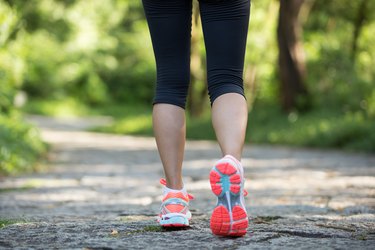
If you're physically active, there's a good chance you've experienced a sports- or exercise-related injury like a calf strain. A strain happens when you injure a muscle or tendon — in this case, the calf or lower leg area.
Depending on the severity of the injury, a doctor or physical therapist may recommend complete rest with some gentle stretches once the pain subsides. But if you're used to moving, you might be wondering if you can do other exercises like the elliptical with a calf strain.
Video of the Day
Video of the Day
Calf Strain Protocol
When it comes to diagnosing a soft tissue injury like a calf strain, your doctor will likely do a series of tests and possibly an X-ray, MRI or ultrasound. A March 2017 clinical review published in the journal Sports Health: A Multidisciplinary Approach found that the use of musculoskeletal ultrasound or sonography in calf injuries can help doctors differentiate between an injury to the posterior compartment and a gastrocnemius strain.
This distinction can help estimate the severity of the injury, pinpoint treatment and monitor healing. While resuming your regular exercise routine or athletic events is the ultimate goal, you need to give your leg time to heal, along with rehab exercises, before jumping back in with both feet.
Immediately after the injury occurs, it's important to start the RICE protocol, according to the American Academy of Orthopaedic Surgeons.
- Rest: After the strain occurs, you need to stop vigorous physical activity and rest the strained calf muscle. Continue walking and standing if the pain is not severe. If the pain is severe, your doctor may recommend crutches.
- Ice: Apply ice to the calf muscle to help reduce swelling. Try to do this as soon as possible after the onset of the injury. Continue icing for 20 minutes, three times a day, for 48 to 72 hours.
- Compression: To help decrease swelling, you can wrap your calf muscle with an elastic bandage.
- Elevation: In the first few days, make sure to prop your leg up on a pillow when you ice the calf muscle.
Exercises With a Calf Strain
You can incorporate calf stretches such as a standing gastrocnemius stretch or a soleus muscle stretch into your rehab. Calf raises on a short step or towel-assisted stretches can also serve as strengthening exercises. That said, you should begin stretching only after the acute phase of the injury and when the majority of the pain is gone.
The American Medical Society for Sports Medicine says light range of motion exercises and activity modification are acceptable for minor strains. As far as resuming regular activity, once your range of motion and strength are close to normal, your doctor may clear you for sports or more vigorous exercise. While the exact time frame is dependent on the severity of the strain and your healing process, it could take up to a couple of months.
When you're cleared for movement beyond stretching, consider light walking, swimming, low-resistance cycling and rowing. Exercising on the elliptical with a calf strain is also an acceptable cardiovascular exercise you can do while healing.
Read more: How to Run With a Calf Strain
Preventing Future Injuries
A February 2017 systematic review published in the British Journal of Sports Medicine evaluated 10 studies about calf strains pertaining to athletes in events like football, rugby, basketball and triathlons. The authors found that increasing age and previous calf injuries are the most predictive of future calf injury or strain.
Since so many calf strains occur during physical activity and, more specifically, sports-related events, taking a preventive approach may help reduce the chance of re-injuring the muscle.
According to Michigan Medicine at the University of Michigan, warming up, cooling down and stretching are three key factors to preventing future calf injuries. You should also consider avoiding any intense activity or sport your body is not conditioned to do.
During the healing phase, Oxford University Hospitals recommends gentle stretches for the calf muscle not only to get you back in the groove of exercise but also to help your knee and ankle move back to their pre-injury position. Adhering to this type of rehab program can help reduce the risk of further injury.
- American Academy of Orthopaedic Surgeons: "Sprains, Strains and Other Soft-Tissue Injuries"
- British Journal of Sports Medicine: "Calf Muscle Strain Injuries in Sport: A Systematic Review of Risk Factors For Injury"
- Sports Health: A Multidisciplinary Approach: "Ultrasound Diagnosis of Calf Injuries"
- Michigan Medicine at the University of Michigan: "Calf Muscle Injury"
- Oxford University Hospital: "Calf Strain Advice"
- American Medical Society for Sports Medicine: "Calf Muscle Strain"
Is this an emergency? If you are experiencing serious medical symptoms, please see the National Library of Medicine’s list of signs you need emergency medical attention or call 911.